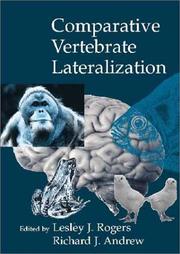| Listing 1 - 10 of 10 |
Sort by
|
Book
ISBN: 9780674058040 9780674062917 0674062914 0674058046 Year: 2012 Publisher: Cambridge, Mass. Harvard University Press
Abstract | Keywords | Export | Availability | Bookmark
 Loading...
Loading...Choose an application
- Reference Manager
- EndNote
- RefWorks (Direct export to RefWorks)
"Monkey see, monkey do" may sound simple, but how an individual perceives and processes the behavior of another is one of the most complex and fascinating questions related to the social life of humans and other primates. In The Primate Mind, experts from around the world take a bottom-up approach to primate social behavior by investigating how the primate mind connects with other minds and exploring the shared neurological basis for imitation, joint action, cooperative behavior, and empathy.In the past, there has been a tendency to ask all-or-nothing questions, such as whether primates possess a theory of mind, have self-awareness, or have culture. A bottom-up approach asks, rather, what are the underlying cognitive processes of such capacities, some of which may be rather basic and widespread. Prominent neuroscientists, psychologists, ethologists, and primatologists use methods ranging from developmental psychology to neurophysiology and neuroimaging to explore these evolutionary foundations.A good example is mirror neurons, first discovered in monkeys but also assumed to be present in humans, that enable a fusing between one's own motor system and the perceived actions of others. This allows individuals to read body language and respond to the emotions of others, interpret their actions and intentions, synchronize and coordinate activities, anticipate the behavior of others, and learn from them. The remarkable social sophistication of primates rests on these basic processes, which are extensively discussed in the pages of this volume.
Primates --- Social psychology. --- Neuropsychology. --- Psychology, Comparative. --- Comparative neurobiology. --- Psychology. --- Comparative neurobiology --- Neuropsychology --- Psychology, Comparative --- Social psychology --- Quadrumana --- Mammals --- Comparative neurology --- Neurobiology --- Psychology
Book
ISBN: 2889193063 9782889193066 Year: 2014 Publisher: Frontiers Media SA
Abstract | Keywords | Export | Availability | Bookmark
 Loading...
Loading...Choose an application
- Reference Manager
- EndNote
- RefWorks (Direct export to RefWorks)
The brain of each animal shows specific traits that reflect its phylogenetic history and its particular lifestyle. Therefore, comparing brains is not just a mere intellectual exercise, but it helps understanding how the brain allows adaptive behavioral strategies to face an ever-changing world and how this complex organ has evolved during phylogeny, giving rise to complex mental processes in humans and other animals. These questions attracted scientists since the times of Santiago Ramon y Cajal one of the founders of comparative neurobiology. In the last decade, this discipline has undergone a true revolution due to the analysis of expression patterns of morphogenetic genes in embryos of different animals. The title of the Research Topic, Adaptive Function and Brain Evolution, stresses the importance of comparative studies to understand brain function and, the reverse, of considering brain function to properly understand brain evolution. This issues should be taken into account when using animals in the research of mental function and dysfunction. The papers of this Research Topic are focused onto the following four Grand Questions of comparative neurobiology: 1) How are different brains built during ontogeny?; 2) What is the anatomical organization of mature brains and how can they be compared?; 3) How do brains work to accomplish their function of ensuring survival and, ultimately, reproductive success?; 4) How have brains evolved during phylogeny?
Comparative neurobiology. --- Neurophysiology. --- Brain --- Brain mapping. --- Anatomy. --- Growth. --- Evolution. --- Connectome mapping --- Mapping of the brain --- Topographic brain mapping --- Nervous system --- Neurobiology --- Physiology --- Comparative neurology --- Localization of functions --- comparative neurobiology --- brain evolution --- phylogeny --- ontogeny

ISBN: 1107129214 128016025X 9786610160259 0511118678 1139146475 0511066929 0511060610 0511307446 0511546378 0511069057 9780511066924 9780511118678 9780511546372 9780511069055 9780511060618 6610160252 0521781612 9780521781619 9780521781619 0521781612 0521787009 9781107129214 9781139146470 9780511307447 9780521787000 Year: 2002 Publisher: Cambridge : Cambridge University Press,
Abstract | Keywords | Export | Availability | Bookmark
 Loading...
Loading...Choose an application
- Reference Manager
- EndNote
- RefWorks (Direct export to RefWorks)
No longer viewed as a characteristic unique to humans, brain lateralization is considered a key property of most, if not all, vertebrates. This field of study provides a firm basis from which to examine a number of important issues in the study of brain and behaviour. This book takes a comparative and integrative approach to lateralization in a wide range of vertebrate species, including humans. It highlights model systems that have proved invaluable in elucidating the function, causes, development, and evolution of lateralization. The book is arranged in four parts, beginning with the evolution of lateralization, moving to its development, to its cognitive dimensions, and finally to its role in memory. Experts in lateralization in lower vertebrates, birds, non-primate mammals, and primates have contributed chapters in which they discuss their own research and consider its implications to humans. The book is suitable for researchers, graduates and advanced undergraduates in psychology, neuroscience and the behavioral sciences.
Cerebral dominance. --- Comparative neurobiology. --- Comparative neurology --- Neurobiology --- Dominance, Cerebral --- Functional asymmetry (Brain) --- Hemispheric dominance (Brain) --- Lateralization (Brain) --- Left and right brain --- Right and left brain --- Cerebral hemispheres --- Dual-brain psychology --- Laterality --- Whole brain learning

ISBN: 080581485X Year: 1995 Publisher: Hove Erlbaum
Abstract | Keywords | Export | Availability | Bookmark
 Loading...
Loading...Choose an application
- Reference Manager
- EndNote
- RefWorks (Direct export to RefWorks)
Comparative neurobiology --- Developmental psychobiology --- Fetal behavior --- Psychology, Comparative --- Behavior, Comparative --- Comparative behavior --- Comparative psychology --- Ethology, Comparative --- Intelligence of animals --- Zoology --- Animal behavior --- Animal intelligence --- Animal psychology --- Human behavior --- Instinct --- Fetus --- Prenatal behavior --- Developmental biology --- Psychobiology --- Comparative neurology --- Neurobiology --- Behavior --- Psychology --- Fetal development --- Intrauterine development --- Development
Periodical
ISSN: 00219967 10969861 Year: 1911 Publisher: Philadelphia, Pa. : Wistar Institute of Anatomy and Biology
Abstract | Keywords | Export | Availability | Bookmark
 Loading...
Loading...Choose an application
- Reference Manager
- EndNote
- RefWorks (Direct export to RefWorks)
Abstracts and fulltext (PDF only), 1997-; Abstracts only, 1996.
Animal psychology and neurophysiology --- Neuropathology --- Zoomorphology. Zooanatomy --- Neurology --- Medicine --- Neurologie --- Periodicals --- periodicals --- Périodiques --- Comparative neurobiology --- Comparative neurobiology. --- Neurology. --- Medicine. --- Neurologie. --- Périodiques. --- United States. --- Health Sciences --- Life Sciences --- Zoology --- Neurobiology. --- Périodiques --- EJMEDEC EPUB-ALPHA-J EPUB-PER-FT MDNEUROL WILEY-E --- periodicals. --- Nervous system --- Neuropsychiatry --- Comparative neurology --- Neurobiology --- Medical Specialities --- Medical Specialties --- Medical Specialty --- Specialities, Medical --- Specialties, Medical --- Specialty, Medical --- Medical Speciality --- Speciality, Medical --- Health Workforce --- Diseases --- Neurobiologie comparée --- Periodicals. --- United States --- Neurobiology, Cellular --- Neurobiology, Molecular --- Cellular Neurobiology --- Molecular Neurobiology --- Neurology - Periodicals

ISBN: 047185767X 0471560715 9780471560715 9780471857679 Year: 1991 Publisher: New York (N.Y.): Wiley-Liss
Abstract | Keywords | Export | Availability | Bookmark
 Loading...
Loading...Choose an application
- Reference Manager
- EndNote
- RefWorks (Direct export to RefWorks)
Animal physiology. Animal biophysics --- Adaptation (Physiology) --- Comparative neurobiology --- Homeostasis --- Metabolism --- Neurophysiology --- Physiology, Comparative --- Adaptation (Physiologie) --- Neurobiologie comparée --- Homéostasie --- Métabolisme --- Neurophysiologie --- Physiologie comparée --- Metabolism. --- Physiology, Comparative. --- physiology --- Neurophysiology. --- 591.1 --- Comparative neurology --- Neurobiology --- Comparative Physiology --- Animal physiology --- Comparative physiology --- Medicine, Comparative --- Zoology --- Biological control systems --- Body fluids --- Physiology --- Compensation (Physiology) --- Plasticity (Physiology) --- Ecophysiology --- Anabolism --- Catabolism --- Metabolism, Primary --- Primary metabolism --- Biochemistry --- physiology. --- Adaption --- Comparative --- Homeostasis. --- Adaption. --- Comparative. --- 591.1 Animal physiology --- Neurobiologie comparée --- Homéostasie --- Métabolisme --- Physiologie comparée --- Homeostasis - physiology --- Metabolism - physiology

ISBN: 1573311111 9781573311106 1573311103 9781573311113 Year: 1998 Volume: 839 Publisher: New York New York academy of sciences
Abstract | Keywords | Export | Availability | Bookmark
 Loading...
Loading...Choose an application
- Reference Manager
- EndNote
- RefWorks (Direct export to RefWorks)
Pathological endocrinology --- Physiology of nerves and sense organs --- Endocrinology,Comparative --- Comparative neurobiology --- Congresses --- Academic collection --- 577.25 --- 591.147 --- 591.18 --- Molecular mechanisms of sensitivity, reception and response to stimuli. Molecular neurobiology --- Internal secretions. Endocrine secretions. Hormones. Adrenalin. Insulin. Sex hormones. Androgens. Oestrogens --- Functions of the nervous system --- Conferences - Meetings --- Congresses. --- 591.18 Functions of the nervous system --- 591.147 Internal secretions. Endocrine secretions. Hormones. Adrenalin. Insulin. Sex hormones. Androgens. Oestrogens --- 577.25 Molecular mechanisms of sensitivity, reception and response to stimuli. Molecular neurobiology --- Comparative neurology --- Neurobiology --- Endocrinology,Comparative - Congresses --- Comparative neurobiology - Congresses

ISBN: 0262042231 9786612097492 0262271419 1282097490 1423746805 9780262042239 9780262271417 9781423746805 Year: 2005 Publisher: Cambridge, Ma : MIT Press,
Abstract | Keywords | Export | Availability | Bookmark
 Loading...
Loading...Choose an application
- Reference Manager
- EndNote
- RefWorks (Direct export to RefWorks)
Leaders in cognitive psychology, comparative biology, and neuroscience discuss patterns of convergence and divergence seen in studies of human and nonhuman primate brains.The extraordinary overlap between human and chimpanzee genomes does not result in an equal overlap between human and chimpanzee thoughts, sensations, perceptions, and emotions; there are considerable similarities but also considerable differences between human and nonhuman primate brains. From Monkey Brain to Human Brain uses the latest findings in cognitive psychology, comparative biology, and neuroscience to look at the complex patterns of convergence and divergence in primate cortical organization and function.Several chapters examine the use of modern technologies to study primate brains, analyzing the potentials and the limitations of neuroimaging as well as genetic and computational approaches. These methods, which can be applied identically across different species of primates, help to highlight the paradox of nonlinear primate evolution--the fact that major changes in brain size and functional complexity resulted from small changes in the genome. Other chapters identify plausible analogs or homologs in nonhuman primates for such human cognitive functions as arithmetic, reading, theory of mind, and altruism; examine the role of parietofrontal circuits in the production and comprehension of actions; analyze the contributions of the prefrontal and cingulate cortices to cognitive control; and explore to what extent visual recognition and visual attention are related in humans and other primates.The Fyssen Foundation is dedicated to encouraging scientific inquiry into the cognitive mechanisms that underlie animal and human behavior and has long sponsored symposia on topics of central importance to the cognitive sciences.
Brain --- Comparative neurobiology --- Primates --- Cerveau --- Neurobiologie comparée --- Evolution --- Congresses --- Congresses. --- Physiology --- Congrès --- Physiologie --- Brain -- Evolution -- Congresses. --- Comparative neurobiology -- Congresses. --- Primates -- Physiology -- Congresses. --- Biological Processes --- Mammals --- Genetic Processes --- Central Nervous System --- Genetic Phenomena --- Biological Science Disciplines --- Vertebrates --- Nervous System --- Biological Phenomena --- Anatomy --- Phenomena and Processes --- Natural Science Disciplines --- Chordata --- Disciplines and Occupations --- Animals --- Eukaryota --- Organisms --- Physiology, Comparative --- Biological Evolution --- Human Anatomy & Physiology --- Health & Biological Sciences --- Neuroscience --- 159.91 --- Psychofysiologie. Neuropsychologie. Psychomotoriek. Psychomotorische therapie --- Conferences - Meetings --- 159.91 Psychofysiologie. Neuropsychologie. Psychomotoriek. Psychomotorische therapie --- Neurobiologie comparée --- Congrès --- Quadrumana --- Comparative neurology --- Cerebrum --- Mind --- Neurobiology --- Central nervous system --- Head --- NEUROSCIENCE/General
Book
ISBN: 9780262016247 0262016249 0262303574 026229737X 9780262303576 Year: 2012 Publisher: Cambridge (Mass.) : MIT Press,
Abstract | Keywords | Export | Availability | Bookmark
 Loading...
Loading...Choose an application
- Reference Manager
- EndNote
- RefWorks (Direct export to RefWorks)
How visual content is represented in neuronal population codes and how to analyze such codes with multivariate techniques. Vision is a massively parallel computational process, in which the retinal image is transformed over a sequence of stages so as to emphasize behaviorally relevant information (such as object category and identity) and deemphasize other information (such as viewpoint and lighting). The processes behind vision operate by concurrent computation and message passing among neurons within a visual area and between different areas. The theoretical concept of "population code" encapsulates the idea that visual content is represented at each stage by the pattern of activity across the local population of neurons. Understanding visual population codes ultimately requires multichannel measurement and multivariate analysis of activity patterns. Over the past decade, the multivariate approach has gained significant momentum in vision research. Functional imaging and cell recording measure brain activity in fundamentally different ways, but they now use similar theoretical concepts and mathematical tools in their modeling and analyses. With a focus on the ventral processing stream thought to underlie object recognition, this book presents recent advances in our understanding of visual population codes, novel multivariate pattern-information analysis techniques, and the beginnings of a unified perspective for cell recording and functional imaging. It serves as an introduction, overview, and reference for scientists and students across disciplines who are interested in human and primate vision and, more generally, in understanding how the brain represents and processes information.
Vision --- Brain --- Neural transmission --- Primates --- Comparative neurobiology --- Multivariate analysis --- Physiological aspects --- Localization of functions --- Physiology --- Comparative neurobiology. --- Multivariate analysis. --- Neural transmission. --- Localization of functions. --- Physiology. --- Physiological aspects. --- Eyesight --- Seeing --- Sight --- Senses and sensation --- Blindfolds --- Eye --- Physiological optics --- Brain function localization --- Cerebral localization --- Localization of cerebral functions --- Neurophysiology --- Phrenology --- Nerve transmission --- Nervous transmission --- Neurotransmission --- Synaptic transmission --- Transmission of nerve impulses --- Neural circuitry --- Neurotransmitters --- Comparative neurology --- Neurobiology --- Multivariate distributions --- Multivariate statistical analysis --- Statistical analysis, Multivariate --- Analysis of variance --- Mathematical statistics --- Matrices --- Functional localization --- Vision - Physiological aspects --- Brain - Localization of functions --- Primates - Physiology --- Primates. --- NEUROSCIENCE/General --- NEUROSCIENCE/Visual Neuroscience --- Quadrumana --- Mammals
Book
ISBN: 3319474294 3319474278 Year: 2017 Publisher: Cham : Springer International Publishing : Imprint: Springer,
Abstract | Keywords | Export | Availability | Bookmark
 Loading...
Loading...Choose an application
- Reference Manager
- EndNote
- RefWorks (Direct export to RefWorks)
This compelling volume provides a broad and accessible overview on the rapidly developing field of social neuroscience. A major goal of the volume is to integrate research findings on the neural basis of social behavior across different levels of analysis from rodent studies on molecular neurobiology to behavioral neuroscience to fMRI imaging data on human social behavior.
Medicine. --- Neurosciences. --- Psychopharmacology. --- Behavioral sciences. --- Biomedicine. --- Behavioral Sciences. --- Social behavior in animals. --- Interpersonal relations. --- Comparative neurobiology. --- Comparative neurology --- Human relations --- Interpersonal relationships --- Personal relations --- Relations, Interpersonal --- Relationships, Interpersonal --- Social behavior --- Neurobiology --- Social psychology --- Object relations (Psychoanalysis) --- Animal behavior --- Animal societies --- Animal behavior. --- Neural sciences --- Neurological sciences --- Neuroscience --- Medical sciences --- Nervous system --- Behavioral pharmacology --- Drugs --- Chemotherapy --- Pharmacology --- Psychotropic drugs --- Animals --- Animals, Habits and behavior of --- Behavior, Animal --- Ethology --- Animal psychology --- Zoology --- Ethologists --- Psychology, Comparative --- Psychotropic effects --- Behavior --- Social sciences --- Behavioral sciences --- Human sciences --- Sciences, Social --- Social science --- Social studies --- Civilization
| Listing 1 - 10 of 10 |
Sort by
|

 Search
Search Feedback
Feedback About
About Help
Help News
News